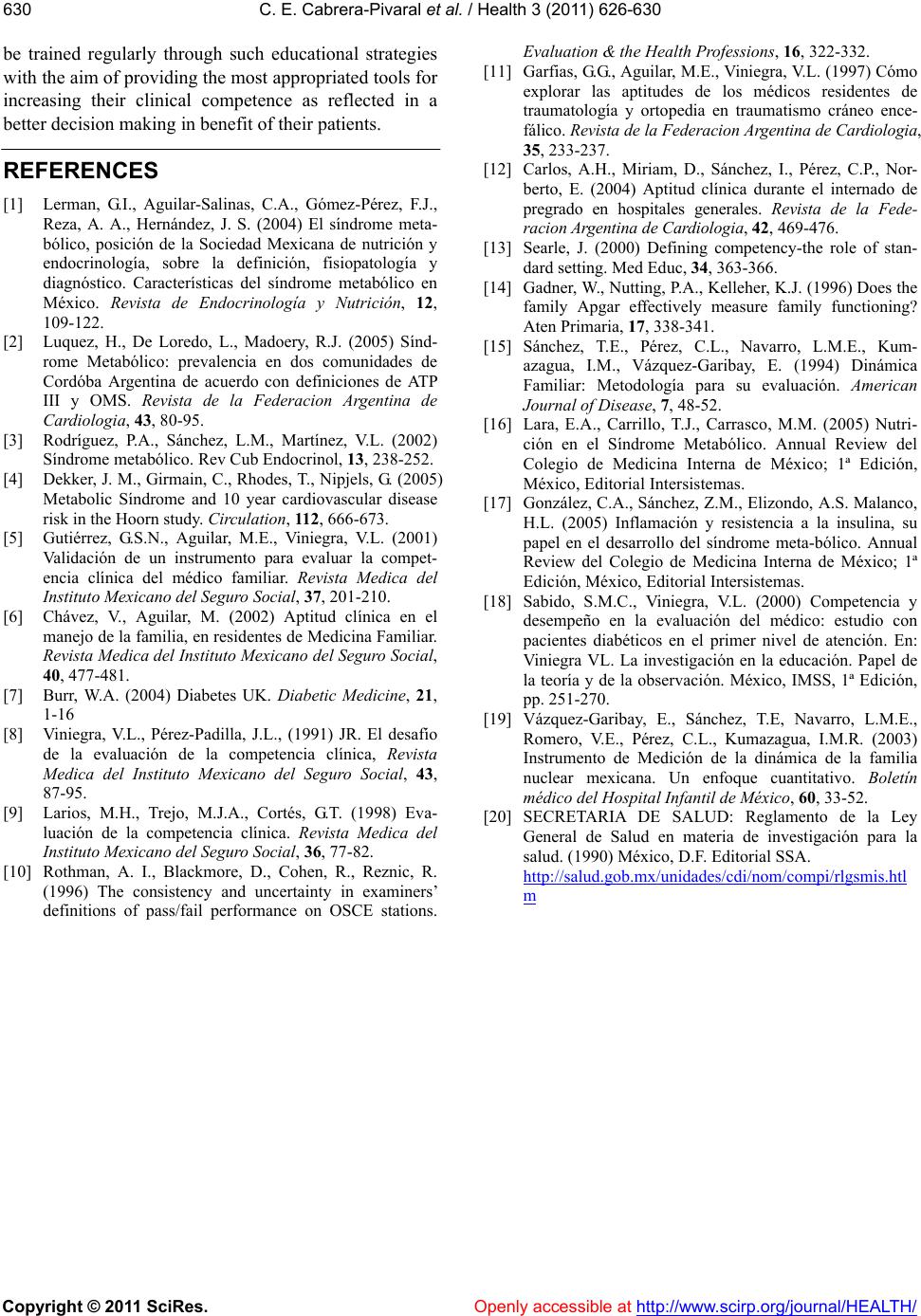
C. E. Cabrera-Pivaral et al. / Health 3 (2011) 626-630
Copyright © 2011 SciRes. Openly accessible at http://www.scirp.org/journal/HEALTH/
630
be trained regularly through such educational strategies
with the aim of providing the most appropriated tools for
increasing their clinical competence as reflected in a
better decision making in benefit of their patients.
REFERENCES
[1] Lerman, G.I., Aguilar-Salinas, C.A., Gómez-Pérez, F.J.,
Reza, A. A., Hernández, J. S. (2004) El síndrome meta-
bólico, posición de la Sociedad Mexicana de nutrición y
endocrinología, sobre la definición, fisiopatología y
diagnóstico. Características del síndrome metabólico en
México. Revista de Endocrinología y Nutrición, 12,
109-122.
[2] Luquez, H., De Loredo, L., Madoery, R.J. (2005) Sínd-
rome Metabólico: prevalencia en dos comunidades de
Cordóba Argentina de acuerdo con definiciones de ATP
III y OMS. Revista de la Federacion Argentina de
Cardiologia, 43, 80-95.
[3] Rodríguez, P.A., Sánchez, L.M., Martínez, V.L. (2002)
Síndrome metabólico. Rev Cub Endocrinol, 13, 238-252.
[4] Dekker, J. M., Girmain, C., Rhodes, T., Nipjels, G. (2005)
Metabolic Síndrome and 10 year cardiovascular disease
risk in the Hoorn study. Circulation, 112, 666-673.
[5] Gutiérrez, G.S.N., Aguilar, M.E., Viniegra, V.L. (2001)
Validación de un instrumento para evaluar la compet-
encia clínica del médico familiar. Revista Medica del
Instituto Mexicano del Seguro Social, 37, 201-210.
[6] Chávez, V., Aguilar, M. (2002) Aptitud clínica en el
manejo de la familia, en residentes de Medicina Familiar.
Revista Medica del Instituto Mexicano del Seguro Social,
40, 477-481.
[7] Burr, W.A. (2004) Diabetes UK. Diabetic Medicine, 21,
1-16
[8] Viniegra, V.L., Pérez-Padilla, J.L., (1991) JR. El desafío
de la evaluación de la competencia clínica, Revista
Medica del Instituto Mexicano del Seguro Social, 43,
87-95.
[9] Larios, M.H., Trejo, M.J.A., Cortés, G.T. (1998) Eva-
luación de la competencia clínica. Revista Medica del
Instituto Mexicano del Seguro Social, 36, 77-82.
[10] Rothman, A. I., Blackmore, D., Cohen, R., Reznic, R.
(1996) The consistency and uncertainty in examiners’
definitions of pass/fail performance on OSCE stations.
Evaluation & the Health Professions, 16, 322-332.
[11] Garfias, G.G., Aguilar, M.E., Viniegra, V.L. (1997) Cómo
explorar las aptitudes de los médicos residentes de
traumatología y ortopedia en traumatismo cráneo ence-
fálico. Revista de la Federacion Argentina de Ca rdiologia,
35, 233-237.
[12] Carlos, A.H., Miriam, D., Sánchez, I., Pérez, C.P., Nor-
berto, E. (2004) Aptitud clínica durante el internado de
pregrado en hospitales generales. Revista de la Fede-
racion Argentina de Cardiologia, 42, 469-476.
[13] Searle, J. (2000) Defining competency-the role of stan-
dard setting. Med Educ, 34, 363-366.
[14] Gadner, W., Nutting, P.A., Kelleher, K.J. (1996) Does the
family Apgar effectively measure family functioning?
Aten Primaria, 17, 338-341.
[15] Sánchez, T.E., Pérez, C.L., Navarro, L.M.E., Kum-
azagua, I.M., Vázquez-Garibay, E. (1994) Dinámica
Familiar: Metodología para su evaluación. American
Journal of Disease, 7, 48-52.
[16] Lara, E.A., Carrillo, T.J., Carrasco, M.M. (2005) Nutri-
ción en el Síndrome Metabólico. Annual Review del
Colegio de Medicina Interna de México; 1ª Edición,
México, Editorial Intersistemas.
[17] González, C.A., Sánchez, Z.M., Elizondo, A.S. Malanco,
H.L. (2005) Inflamación y resistencia a la insulina, su
papel en el desarrollo del síndrome meta-bólico. Annual
Review del Colegio de Medicina Interna de México; 1ª
Edición, México, Editorial Intersistemas.
[18] Sabido, S.M.C., Viniegra, V.L. (2000) Competencia y
desempeño en la evaluación del médico: estudio con
pacientes diabéticos en el primer nivel de atención. En:
Viniegra VL. La investigación en la educación. Papel de
la teoría y de la observación. México, IMSS, 1ª Edición,
pp. 251-270.
[19] Vázquez-Garibay, E., Sánchez, T.E, Navarro, L.M.E.,
Romero, V.E., Pérez, C.L., Kumazagua, I.M.R. (2003)
Instrumento de Medición de la dinámica de la familia
nuclear mexicana. Un enfoque cuantitativo. Boletín
médico del Hospital Infantil de México, 60, 33-52.
[20] SECRETARIA DE SALUD: Reglamento de la Ley
General de Salud en materia de investigación para la
salud. (1990) México, D.F. Editorial SSA.
http://salud.gob.mx/unidades/cdi/nom/compi/rlgsmis.htl
m